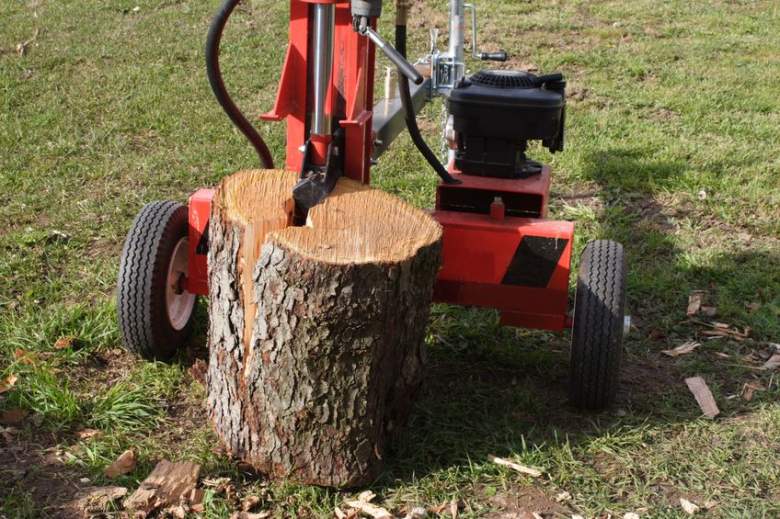
If you use firewood to heat your home, you may want to give your ax a rest and consider using an efficient log splitter. Log splitters are machines that force a wedge with immense pressure to efficiently and quickly split logs apart.
Log splitters (also known as wood splitters) come in a variety of sizes based on what your needs are. They can be powered manually or by using electricity or gasoline. If your muscles and joints begin to ache when the leaves start falling, a log splitter might be a great addition to your chainsaw and the rest of your home and yard tool inventory.
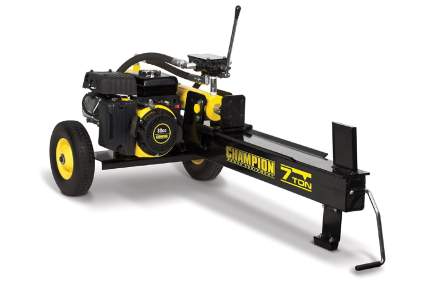
|
Amazon Customer Reviews
|
Price: $599.99 Shop at Amazon | Shop now Read our review |
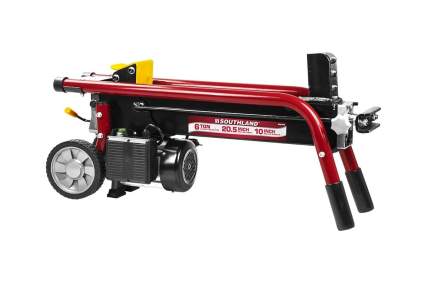
|
Amazon Customer Reviews
|
Price: $558.15 Shop at Amazon | Shop now Read our review |
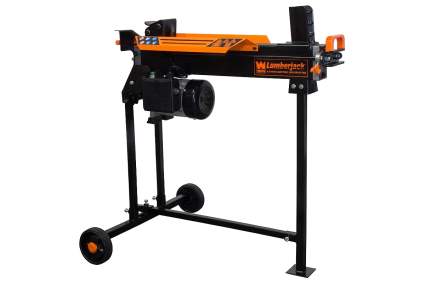
|
Amazon Customer Reviews
|
Price: $465.50 Shop at Amazon | Shop now Read our review |
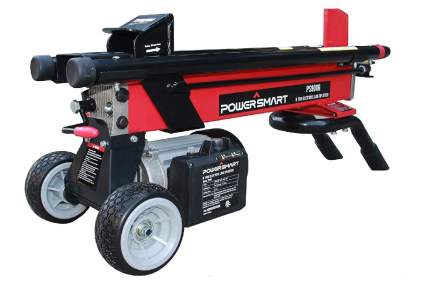
|
Amazon Customer Reviews
|
Price: $379.97 Shop at Amazon | Shop now Read our review |
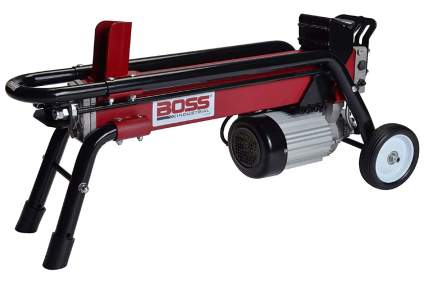
|
Amazon Customer Reviews
|
Price: $519.00 Shop at Amazon | Shop now Read our review |
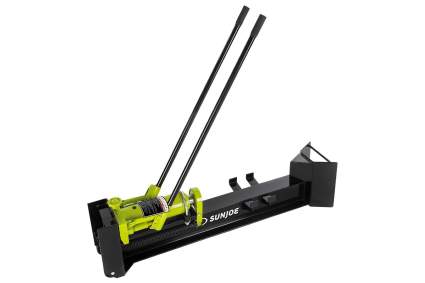
|
Amazon Customer Reviews
|
Price: $249.00 Shop at Amazon | Shop now Read our review |
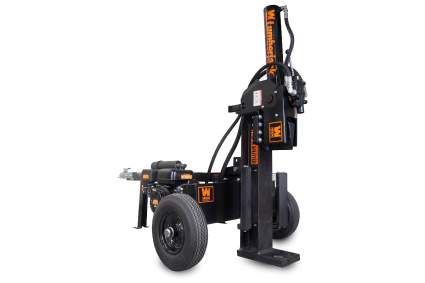
|
Amazon Customer Reviews
|
Price: $1,354.82 Shop at Amazon | Shop now Read our review |
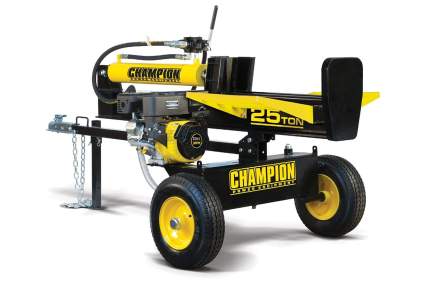
|
Amazon Customer Reviews
|
Price: $2,398.33 Shop at Amazon | Shop now Read our review |

|
Amazon Customer Reviews
|
Price: $2,304.43 Shop at Amazon | Shop now Read our review |
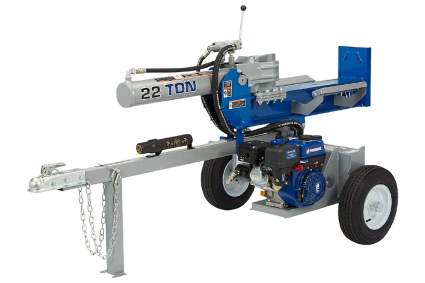
|
Amazon Customer Reviews
|
Price: $1,549.99 Shop at Amazon | Shop now Read our review |
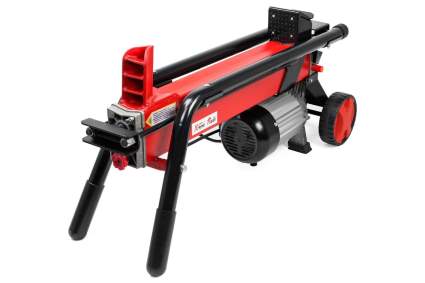
|
Amazon Customer Reviews
|
Price: $309.95 Shop at Amazon | Shop now Read our review |
-
1. Champion 7-Ton Compact Horizontal Gas Log Splitter
Pros:- 80cc 4-stroke gas engine
- Large 10-inch wheels
- Can handle a much wider diameter of log than electric models
Cons:- Hydraulic tank vent screw isn't secured to prevent loss during operation
- Gas-powered performance but expensive considering electric models can do more at less than half the price
- Pneumatic tires would be a nice touch
With an 80cc gas-powered engine and a lightweight 50-pound footprint, the Champion 7-Ton Compact Horizontal Gas Log Splitter will keep going as long as you have fuel to top the tank. The splitter features a 20-second cycle time and auto-return valve to help reduce your work time as well as a skewed wedge to improve the overall efficiency. Seven tons of force is a nice size for home use and the gas engine will make sure you get every bit of that force to slice through cord after cord of firewood.
The low-profile design makes it easier to load a large log onto the splitting beam and the cradle will keep it safely in position. The machine can handle logs up to 19 inches and weighing up to 50 pounds. The hydraulic system powered by the 80cc engine will get through what you need it to when you need it. This log splitter will easily fit in the back of a truck and easy to move from one job to the next with the convenient handle and large 10-inch never-flat tires.
Find more Champion 7-Ton Compact Horizontal Gas Log Splitter information and reviews here.
-
2. Southland Outdoor Power Equipment SELS60 6-Ton Electric Log Splitter
Pros:- Heavy-duty splitter at a great price
- Adjustable length settings
- Quick setup process to get working
Cons:- Small transport wheels
- No receiving tray for split pieces
- Requires two hands to operate and is awkward
If you’re looking to split a load of firewood effectively and quickly, look no further than the Southland SELS60 6-Ton Electric Log Splitter. It features a 1.75 HP 15 Amp induction motor to get you the performance you’re looking for in a minimum amount of time. This machine features an 18-second cycle time between when you start the split and the wedge resets to go again.
With six tons of force, the log splitter can efficiently cleave logs up to 20-1/2-inches long and 10 inches around. An integrated stroke limiter can adjust to a shorter stroke for smaller logs. Portability? Get out of here! Of course, this splitter is portable; it features 7-inch wheels and legs that double as handles to move it around. This is a great machine for a great price.
Find more Southland SELS60 6-Ton Electric Log Splitter information and reviews here.
-
3. WEN 56207 6.5-Ton Electric Log Splitter
Pros:- 15 Amps provide 13,000 pounds of pressure
- Includes stand to elevate machine to counter height if desired
- Adjustable push plate travel distance for smaller logs
Cons:- Wheels are much too small
- Two-handed operation is really awkward
- Would be nice if ram went just a bit further toward wedge
The WEN 6.5-Ton Electric Log Splitter includes a square tube steel stand that elevates the unit to counter height to help save your lower back when chopping up your firewood. If you wish to use closer to the ground like other similar log splitters, you can do that as well. This unit features a powerful 15 Amp motor that will efficiently slice logs up to 10 inches in diameter and 20-1/2-inches in length.
Cycle time is a nice 20 seconds to get through that load of cedar you just had delivered. The splitter features a 14.75-inch cylinder stroke, 16-square-inch push plate, and 5-inch wedge to get through hardwoods as well as the easy stuff. When you’re all done for the day, roll this wood splitter back to the shed with the on-board pull handle and the two never-flat 5-1/2-inch wheels.
Find more WEN 56207 6.5-Ton Electric Log Splitter information and reviews here.
-
4. Powersmart 6-Ton Electric Log Splitter
Pros:- 6 tons of driving force
- Strong steel construction
- Large rubberized wheels for mobility
Cons:- Two handed operation is awkward
- Low to the ground so you'll have to stoop a bit to use it
- No log cradle to collect split wood
The Powersmart 6-Ton Electric Log Splitter is a standard light use machine that works well for any homeowner looking to split logs once in a while. It’s not especially easy to use as it’s low to the ground and it requires two hands to operate for safety reasons however for what it does (and especially its price), it’s a good buy.
This log splitter uses standard household current to work and will split logs up to 21 inches long and ten inches in diameter. I really liked the oversized wheels with the rubber tread for mobility. This unit can be wheeled anywhere and used as is or it can be lifted to a worktable.
While there is a steel tube frame around the splitting cradle, there isn’t really anything to catch firewood after it’s been split. This log splitter is effective and a good value but be aware that there aren’t any bells or whistles to make your job easier.
Find more Powersmart 6-Ton Electric Log Splitter information and reviews here.
-
5. Boss Industrial ES7T20 7-Ton Electric Log Splitter
Pros:- Wheels are larger than most splitters this size
- Easy to transport in a truck or SUV
- Quieter and less noxious than a gas-powered log splitter
Cons:- Splitting wedge could stand to be taller
- Machine sits very close to ground
- No option to set ram for shorter logs
The Boss Industrial ES7T20 7-Ton Electric Log Splitter offers some amazing quality and performance with a 2HP electric motor that delivers seven tons of splitting force without the noise, exhaust, or mess that gas engines create. If you want to split outside or indoors, this wood splitter can make that happen. The cycle time is also a reasonable 10 to 12 seconds which is somewhat quick for a small, electric log splitter.
The machine features automatic return and built-in side rails that keep logs stable while splitting. The large steel tube rails and handlebars (that double as legs) makes this splitter one of the few that firmly plants down when ready for work. No tippiness here like in some other models.
The ES7T20 also has larger no-flat wheels which, for this size of machine, work fairly well for transport. The great thing about this model is the one-handed operation which makes splitting wood a lot less awkward. The Boss Industrial ES7T20 is a good splitting machine for a good price.
Find more Boss Industrial ES7T20 7-Ton Electric Log Splitter information and reviews here.
-
6. Sun Joe LJ10M 10-Ton Hydraulic Log Splitter
Pros:- Nice way to get a workout and cut up a good pile of wood without killing yourself
- Works great on seasoned hardwoods
- Compact profile allows for small storage footprint
Cons:- 18-inch maximum working length is shorther than you might think
- Expensive for it being a manual machine
- Easy to transport but it's heavy
- It could use larger wheels
This Sun Joe LJ10M 10-Ton Hydraulic Log Splitter is just the thing you need to chop up that pile of logs and get your heart pumping without the extreme cardio required by doing it all by hand. Powered manually by a two-speed pump, the log splitter will quickly generate up to ten tons of force to split through firewood up to 18 inches long and 8 inches in diameter.
The LJ10M is made of durable steel so it will handle what you throw at it year after years. The log cradle keeps the split wood from falling through (forcing you to bend over to retrieve it) while the ram return spring resets the wedge quickly so you can get more done with the turn of a knob. Long handles mean your back doesn’t get as sore while you’re working in the field.
And once you’re done, simply move the wood splitter back to the woodshed using the rear wheels. This log splitter is easy to transport and maneuver where you want it. Its reasonable size makes it easy to store once you get it there.
Find more Sun Joe LJ10M 10-Ton Hydraulic Log Splitter information and reviews here.
-
7. WEN 56222 Lumberjack 22-Ton Gas-Powered Log Splitter
Pros:- Towable frame with two-inch ball hitch can travel up to 45 MPH
- Four hours of half-load runtime from one gallon of gasoline
- Large log cradles
Cons:- Two-handed operation
- Expensive but appropriate for this size of a machine
- Log cradles feel flimsy considering the stout build for the rest of the splitter
Now you’re playing with the big kids! The WEN 56222 Lumberjack 22-Ton Gas-Powered Log Splitter will quickly turn that pile of wood into another pile of wood, just in smaller pieces. This towable splitter features heavy-gauge welded steel construction and a 212cc gas-powered engine that will split logs up to 14-inches in diameter and 25-inches long.
The 4 x 24-inch hydraulic cylinder and 10 GPM two-stage pump work together to drive the 7-inch heat-treated steel wedge directly through the middle of any log unlucky enough to stand in the way. Just one gallon of gasoline will power this big boy for over four hours of half-load runtime. This splitter requires two hands to operate it which is a shame however it might be a good idea due to the size of the machine.
This log splitter was meant to be towed to the job site and used all day. The vertical working setup is nice so you don’t have to lift those logs up into the cradle. It features a standard two-inch ball hitch and the 16-inch tires can handle towing speeds of up to 45 MPH. That big pile of logs better watch out because here you come with the WEN Lumberjack.
Find more WEN 56222 Lumberjack 22-Ton Gas-Powered Log Splitter information and reviews here.
-
8. Champion 25-Ton Horizontal/Vertical Full Beam Gas-Powered Log Splitter
Pros:- Skewed wedge easily cuts through hardwood
- Grated log catchers
- Heavy-duty full reinforced beam
Cons:- Make sure you have at least two fellas to put this beast together
- Hydraulic lines feature barbed fittings which may loosen after time
- Cut-off switch is inconveniently located on the inside of the control panel
25 tons of force can chop a lot of logs easily with a 224cc gas-powered engine and that’s what you’re getting with the Champion 25-Ton Horizontal/Vertical Full Beam Gas-Powered Log Splitter. This baby serves up a 12-second cycle time between each log and can convert from horizontal to vertical operation in seconds. This size of a splitter offers up a wedge pushing down against the log resting against the brace at the end instead of the other way around with smaller models.
Log catchers bolted to the side of the main beam are heavy-duty and feature rails to allow debris to fall through instead of clogging up your working area. The beam is reinforced to give you years of faithful service. The Champion 25-Ton Log Splitter is towable up to 45 MPH with a two-inch ball hitch and 16-inch air-filled tires. And what’s more, you can’t beat that bright yellow paint job beckoning you to the outdoors for some playtime.
-
9. Yardmax YS2865 28-Ton Half-Beam Log Splitter
Pros:- Superior U-beam structural design
- Hyrdraulic oil filter is mounted insdie the reservoir
- Equal weight distribution and wear reduction
Cons:- Yardmax claims one-person assembly but it's really a two-person job
- Four-way splitter head isn't useful and actually a hindrance
- Trailer stand leg needs reinforcement
The rugged Yardmax YS2865 28-Ton Half-Beam Log Splitter comes with a number of nice design enhancements that should equal better performance over the long life of your wood splitting machine. The half-beam construction is a U-shape which Yardmax claims to be stronger than a standard I-beam. This splitter can be used in a horizontal position with two sturdy log cradles on each side of the beam or in vertical mode for easy positioning of logs to be split.
The YS2865 features a 208cc, 6.5HP Briggs & Stratton gas-powered engine that easily and effectively brings 28 tons of force down onto any type of logs that you see fit to chop. With oversized hydraulic components, short 13-second cycle times, and dual-end cylinder support for equal weight distribution, the splitter is a lot of fun to use. Fully towable up to 45 MPH, make sure to bring the Yardmax YS2865 to the chop site and get ready to get things done.
Find more Yardmax YS2865 28-Ton Half-Beam Log Splitter information and reviews here.
-
10. Powerhorse 212cc 22-Ton Gas-Powered Log Splitter
Pros:- Heavy-duty hydraulic system prevents contaminants from entering system
- Multiple filters with high tolerances to keep components fresh and lubricated
- Reinforced, thick-plated, steel construction reduces log jams
Cons:- Less expensive than other 22-ton splitters...but shipping is additional
- Parts are heavy making assembly potentially troublesome for one person
- Assembly directions are unclear
This heavy-duty Powerhorse 212cc 22-Ton Gas-Powered Log Splitter combines strength and towing ability to create a wood splitter that is powerful and efficient. The hydraulic system includes a superior quality valve, wire-reinforced hoses, an 11 GPM cast-iron pump with heavy-duty bracket, and a Zinga-made filter.
Powerhorse is very proud of the various filters that protect the internal components of this splitter. In fact, this is the only log splitter I found that promoted its hydraulic system in such glowing terms providing the micron and mesh sizes of four different filters. That’s encouraging news for anyone not familiar with dealing with hydraulic fluid and potential leaks.
The entire unit is built with stout materials and attention to detail including industrial-strength components, high-quality ball bearings, a low oil shutdown, cast iron sleeve, and a steel fuel tank. The Powerhorse can be used in either a horizontal or vertical position which is nice when dealing with large logs. The tapered wedge splits all types of woods up to 25 inches long and 14 inches in diameter with ease.
Several online reviews claimed that assembly was a whole lot easier when handled by two or more people. Get your buddy a beer and settle in for a few hours of tinkering.
Find more Powerhorse 212cc 22-Ton Gas-Powered Log Splitter information and reviews here.
-
11. XtremepowerUS 7-Ton 15 Amp Electric Log Splitter
Pros:- Built-in log cradle
- Seven tons of splitting force
- Splits seasoned wood very well
Cons:- Can't handle harder woods like oak or maple very well
- Valves may stick
- Sits low to ground
For such a small machine, the XtremepowerUS Electric Log Splitter offers up seven tons of horizontal force powered by a 2 HP 15 Amp electric motor. If you’re dealing with softer woods that are well seasoned, this little splitter will get right after it. If you have hardwoods like maple or oak, you may want to find another option.
The wood splitter is very portable, sporting 7-inch wheels and nice, cushioned handles to move it around. It can accommodate logs up to just over 20 inches long and ten in diameter. All-steel construction and decent weatherproofing means this splitter should operate admirably for a number of years. All in all, I was surprised by the performance of an off-brand machine of this size.
Find more XtremepowerUS 7-Ton 15 Amp Electric Log Splitter information and reviews here.
Is It Worth Buying A Log Splitter?
The answer to that question depends on a couple more very important questions. First, how much longer can you physically keep doing the work? And secondly, how much time do you have to spend on splitting wood?
There’s no doubt that cleaving logs with an ax and a maul (and sometimes with a gas or electric chainsaw) is incredibly satisfying not only as a way to exercise but the stress relief benefits can be impressive as well. However, if you burn wood as a source of heat during the winter, adding a log splitter to your tool shed is a nice option if your shoulders and back need a break.
As I get older, the tasks I used to churn out in an hour without thinking of it take me a little longer as I inch closer to that half-century mark. I’m starting to think about how more valuable time is than money these days.
By getting done in a weekend what might take me several days (or even weeks), a wood splitter will pay for itself very quickly. I'm going to need a heavy-duty wheelbarrow or a utility wagon to move all that firewood around. Now I’m listening.
You may need to cut less than a cord of wood each year and if that’s the case, then perhaps renting one is a good idea. But that means driving down, loading it, or trailering it home, getting all your work done (typically within four hours), then cleaning up the machine so you can get it back to the rental shop. Whew!
Log splitters come in a variety of sizes and price levels so the initial investment will vary based on your needs. Once you begin to look for what’s out there, I think you’ll find it amazing what kind of great machine you can purchase for just a few hundred bucks.
Consider also that purchasing a log splitter now should more than pay for a few years of renting one. If wood heat is what you will depend on, a wood splitter makes a lot more sense in the long run.
Like all power tools, you get what you pay for. Try not to save pennies by tripping over dollars! Investing in a quality tool now will save you money (not to mention your back) over the years of using it.
How Big of a Log Splitter Do I Need?
Congratulations on making the decision to pick up a log splitter! Now that you’re here, you’ll want to take into account a few different criteria on what machine will be best for your needs, your home, and your workload.
Look at the type of wood you’re splitting. How large are the logs? What’s the average length? Is the wood seasoned or is it still green? How big of a pile do you need to get through? If you have a cord of small logs made of softer wood like pine and it’s been drying for a couple of years, you’ll need a much smaller log splitter.
Log splitter tonnage and cycle time are going to come into play as well. Tonnage is the amount of force the splitter uses on the logs. A larger number means more force as you might imagine. Cycle time is how fast the machine works. Larger tonnage typically means more cycle time and vice versa.
Bigger isn’t necessarily better when it comes to choosing a log splitter. Depending on your situation, don’t overpay for a machine that outstrips your needs. On the other hand, using a machine that is completely underpowered for a job is absolutely miserable.
For most average households, a log splitter that produces seven tons of force is probably adequate. These machines are rated for logs around ten inches around and that are made of a soft to medium density.
Wood that is larger or harder than that (I’m looking at you, oak) will need a splitter that puts out 20 tons of force. These machines are larger and most likely powered by gasoline. They’re towable and can split logs vertically, a nice feature. If you’re splitting more than seven or eight cords of wood a year, this will definitely be your benchmark.
If you need to cleave larger logs than that, I’m impressed. There are wood splitters for sale that features a 35-ton rating that will get through the toughest, greenest hickory logs larger than 24 inches in diameter. If you get one of those, invite me over so you can show off.
What are the Different Types of Log Splitters?
There are three types of log splitters: manual, hydraulic, and kinetic. Each have their own unique amenities, speed levels, and price levels. Which you choose to go with will depend on what you need one for.
Manual models work using long handles and leverage. They don’t require gas nor electricity to operate however they require more physical labor. They’re smaller and more portable which means they take less space to store away.
Manual log splitters don’t make the noise or emit fumes like gas models but they also take longer to chop wood. On the plus side, they’re the least expensive of the log splitters on sale.
Gas or electric-powered hydraulic splitters are the most universal of machines out there to chop wood. Like all motorized machines, gas engines typically are more powerful than electric ones. If you have hardwood logs that are full of knots, a gas wood splitter will make things much easier as well as not requiring an electrical outlet to be nearby.
Electric log splitters run clean so they can be used inside a garage or shop with no fear of carbon monoxide poisoning, a real plus during cold winter months. They don’t need much room to set up or operate, another plus when you don’t require to split a lot of wood ahead of time. I have more to say about gas versus electric models below.
Kinetic splitters are machines for people who want to get through a lot of wood fast. Their cycle time (the time it takes to cut and reset) is much less than a hydraulic splitter, sometimes down to a second for the larger machines.
Kinetic log splitters are also easier to maintain without oil leaks or problems with hydraulic fluid. The largest drawback with these types of wood splitters is that their speed can sometimes reduce their effectiveness and power.
Consider how much wood that you have to split. The log splitter’s motor power, quality, and reputation will be important to note. More horsepower and hydraulic capacity means stronger and faster operation. Are replacement parts available quickly and easily for your wood splitter?
Do Electric Log Splitters Really Work?
In short, yes. Electric log splitters can be a very effective solution to cutting wood for your stove. As referenced above, electric log splitters tend to be smaller and lighter with a tonnage of approximately five to seven tons. They’re good to use in an enclosed area since they don’t produce exhaust. Electric splitters are excellent for light to medium wood chopping work.
For timber larger than ten inches in diameter and for hardwoods like maple and hickory, gas-powered splitters are really the best solution. They can produce more force and produce it faster. Gas hydraulic splitters can also work vertically, saving you from having to lift heavy logs into the chamber.
Also, keep in mind that dual-wedge splitters exist which primarily feature gasoline-powered engines. They are designed so that if one wedge hits a knot, the log will continue to be split by another wedge on the other side. That’s really handy especially if you’re looking at a few cords of oak that need attention with a snowstorm on its way.
One more thing: depending on how large the wood is that you're splitting and how strong your back is, you may need some help moving logs around. A timberjack is a great option if you're looking at moving a large number of log rounds.
Take a look at this LogOX 3-In-1 Forestry Multitool. It reduces strain on your back and arms when moving those loading up your load splitter. LogOX also produces a simpler log hauler tool as well.
See Also: